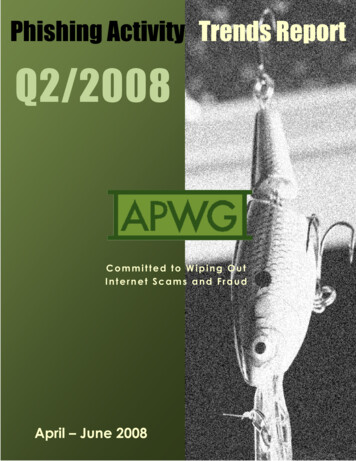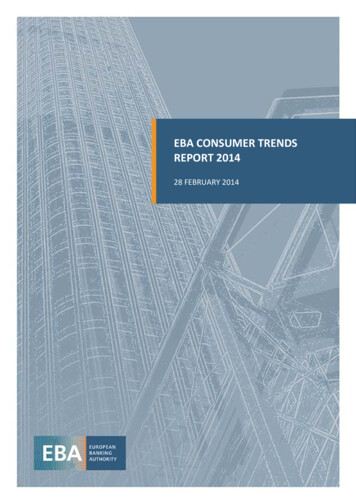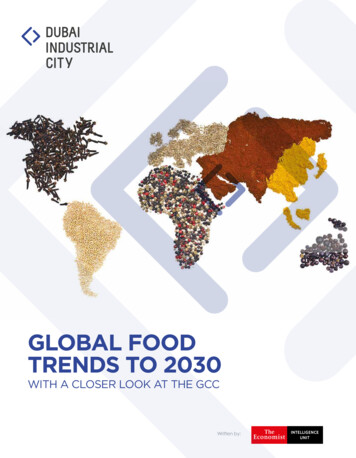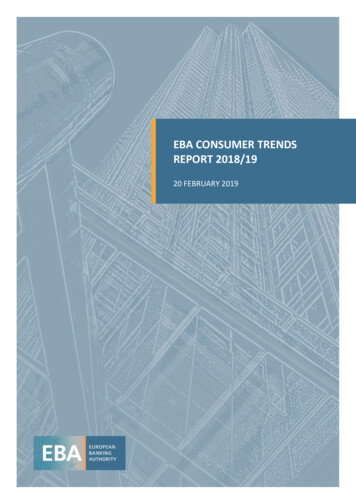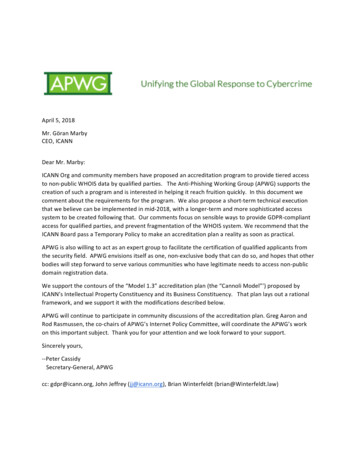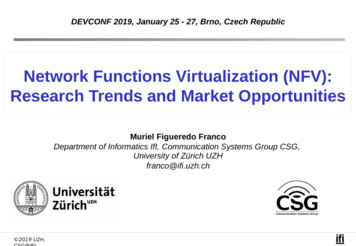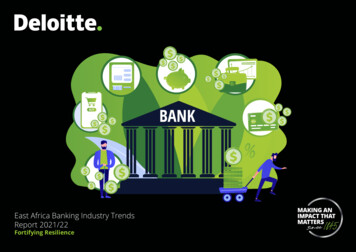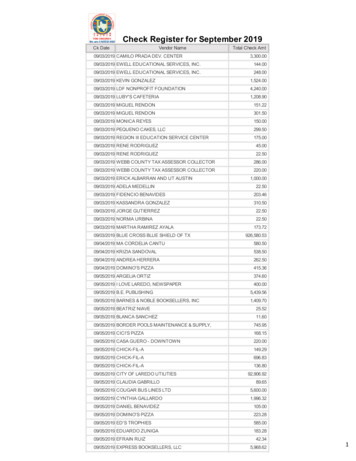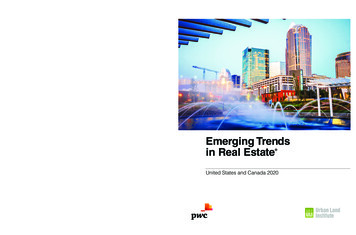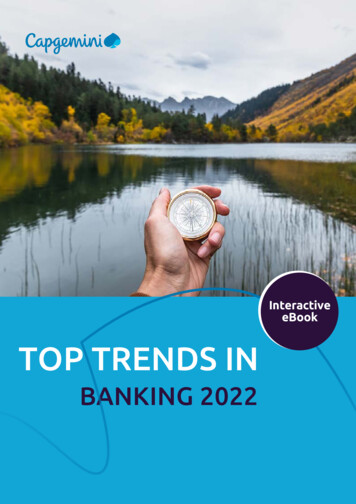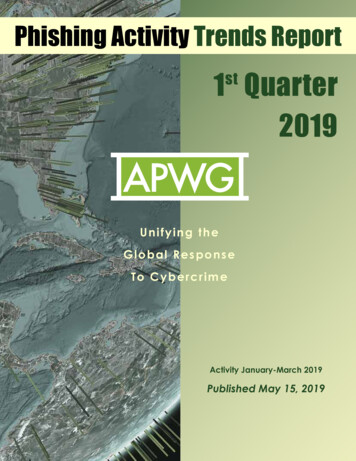
Transcription
Phishing Activity Trends Report1 Quarter2019stUni f yin g th eGlo bal Res po ns eTo C yb er cr im eTable of ContentsStatistical Highlights for 2nd Quarter 20173Phishing E-mail Reports and Phishing Site Trends4Brand-Domain Pairs Measurement5Brands & Legitimate Entities Hijacked byE-mail Phishing Attacks6Use of Domain Names for Phishing7-9Phishing and Identity Theft in Brazil10-11Most Targeted Industry Sectors12APWG Phishing Trends Report Contributors13Activity January-March 2019Published May 15, 2019
Phishing Activity Trends Report, 1st Quarter 2019Phishing of SaaS and Webmail BrandsSurpasses Payment Brands for First TimePhishing Report ScopeThe APWG Phishing Activity Trends Report analyzesphishing attacks reported to the APWG by its membercompanies, its Global Research Partners, through theorganization’s website at http://www.apwg.org, and bye-mail submissions to reportphishing@antiphishing.org.APWG also measures the evolution, proliferation, andpropagation of crimeware by drawing from the researchof our member companies.Phishing DefinedPhishing is a criminal mechanism employing both socialengineering and technical subterfuge to steal consumers’personal identity data and financial account credentials.Social engineering schemes use spoofed e-mailspurporting to be from legitimate businesses andagencies, designed to lead consumers to counterfeit Websites that trick recipients into divulging financial datasuch as usernames and passwords. Technical subterfugeschemes plant crimeware onto PCs to steal credentialsdirectly, often using systems to intercept consumersonline account user names and passwords -- and tocorrupt local navigational infrastructures to misdirectconsumers to counterfeit Web sites (or authentic Websites through phisher-controlled proxies used to monitorand intercept consumers’ keystrokes).1st Quarter 2019 Phishing Activity Trends Summary Phishing that targeted Software-as-a-Service (SaaS)and webmail services became the biggest categoryof phishing. At 36 percent of all phishing attacks,it eclipsed phishing against the payment servicescategory for the first time. [p. 5] The total number of phishing sites detected byAPWG in the first quarter of 2019 was up notablyover the third and fourth quarters of 2018. [p. 4] The number of phishing attacks hosted on Websites that have HTTPS and SSL certificates reacheda new high. [p. 6] In Brazil, mobile phishing rose, and phishers alsoattacked SaaS providers. Cybercriminals alsodeployed malware that targeted multiple banks ata time. [p. 7]Table of ContentsStatistical Highlights for 4th Quarter 20183Phishing Site and Phishing E-mail Trends4Most-Targeted Industry Sectors5How Phishers use Encryption to Fool Users6Phishing and Identity Theft in Brazil7APWG Phishing Trends Report Contributors92Phishing Activity Trends Report1st Quarter 2019www.apwg.org info@apwg.org!
Phishing Activity Trends Report, 1st Quarter 2019Statistical Highlights for 1st Quarter 2019JanuaryFebruaryMarchNumber of unique phishing Web sites detected48,66350,98381,122Number of unique phishing e-mail reports (campaigns)34,63035,36442,399327288330received by APWG from consumersNumber of brands targeted by phishing campaignsThe APWG continues to refine its tracking and reporting methodology and to incorporate new datasources into our reports.The APWG tracks the number of unique phishing Web sites. This is now determined by the unique baseURLs of the phishing sites. (A single phishing site may be advertised as thousands of customized URLs,all leading to basically the same attack destination.) APWG’s contributing members report phishing URLsinto APWG. The contributing members also track a variety of additional metrics and data sets in order totrack the fast-paced nature of cybercrime.APWG also tracks and reports the number of unique phishing reports (email campaigns) it receives fromconsumers. An e-mail campaign is a unique e-mail sent out to multiple users, directing them to a specificphishing web site (multiple campaigns may point to the same web site). APWG counts unique phishingreport e-mails as those found in a given month that have the same email subject line.3Phishing Activity Trends Report1st Quarter 2019www.apwg.org info@apwg.org!
Phishing Activity Trends Report, 1st Quarter 2019Phishing Site and Phishing E-mail Trends – 1st Quarter 2019The total number of phishing sites detected by APWG in 1Q was 180,768. That was up notably from the138,328 seen in 4Q 2018, and from the 151,014 seen in 3Q 2018.Phishing Sites, -19The number of unique phishing reports submitted to APWG during 1Q 2019 was 112,393. These werephishing emails submitted to APWG, and exclude phishing URLs reported by APWG members directly intoAPWG’s eCrime eXchange.Unique Phishing Reports Received fromConsumers, ,0005,0000Jan-19Feb-19Mar-194Phishing Activity Trends Report1st Quarter 2019www.apwg.org info@apwg.org!
Phishing Activity Trends Report, 1st Quarter 2019Most-Targeted Industry Sectors – 4th Quarter 2018In 1Q 2019, APWG member MarkMonitor saw phishing that targeted Software-as-a-Service (SaaS) andwebmail services jump to 36 percent of all phishing attacks. That’s up significantly from 30 percent in 4Q2018 and 20.1 percent in 3Q 2018. Phishing against the SaaS and webmail category became the biggestcategory of phishing, eclipsing phishing against the payment services category for the first time.Attacks against cloud storage and file hosting sites continued to drop, decreasing from 11.3 percent of allattacks in Q1 2018 to just 2 percent in 1Q 2019. Founding APWG member MarkMonitor is an online brandprotection organization, securing intellectual property and reputations through anti-fraud, brandprotection, domain management, and anti-piracy solutions.MOST-TARGETED INDUSTRY SECTORS,1Q2019SAAS /Webmail36%Payment27%eCommerce Phishing Activity Trends Report1st Quarter 2019www.apwg.org info@apwg.org!
Phishing Activity Trends Report, 1st Quarter 2019Howwere Phishersin .COM,Use Encryption to Fool VictimsAPWG contributor PhishLabs has been tracking the numbers of phishing sites protected by the HTTPSencryption protocol. HTTPS is used to secure communications by encrypting the data exchanged betweena person’s browser and the web site he or she is visiting. HTTPS is especially important on sites that offeronline sales or password-protected accounts. Studying HTTP on phishing sites provides insight into howphishers are fooling Internet users by turning an Internet security feature against them (typically by usingthe HTTPS protocol’s lock icon in the browser address bar to assure users that the domain itself is ‘safe’).PhishLabs provides managed security services that help organizations protect against phishing attackstargeting their employees and their customers.“In Q1 2019, 58 percent of phishing sites were using SSL certificates, a significant increase from the priorquarter where 46 percent were using certificates,” said John LaCour, CTO of PhishLabs. “There are tworeasons we see more. Attackers can easily create free DV (Domain Validated) certificates, and more websites are using SSL in general. More web sites are using SSL because browser warning users when SSL isnot used. And most phishing is hosted on hacked, legitimate sites.”% of Phishing Attacks Hosted on HTTPS60%% OF PHISHING ATTACKS50%40%30%20%10%0%Q1 Q2 Q3 Q4 Q1 Q2 Q3 Q4 Q1 Q2 Q3 Q4 Q1 Q2 Q3 Q4 Q12015 2015 2015 2015 2016 2016 2016 2016 2017 2017 2017 2017 2018 2018 2018 2018 20196Phishing Activity Trends Report1st Quarter 2019www.apwg.org info@apwg.org!
Phishing Activity Trends Report, 1st Quarter 2019Online Criminal Activity in BrazilAPWG member company Axur is located in Brazil and concentrates on protecting companies and theirusers in Brazil from Internet-based threats. Axur especially monitors attacks against banks, technologyfirms, airlines, and online marketplaces located in the country. Axur’s data shows how criminals areperpetrating identity theft in South America’s largest economy, and shows how these incidents are both alocal and international problems.In the first quarter of 2019, Axur observed 3,220 cases of phishing and 180 cases of malware. Specifically,these were attacks against Brazilian brands or against foreign services that are available in Portuguese inBrazil.In Brazil, the amount of phishing -- especially mobile phishing -- increased in the first quarter of 2019:Phishing and Malware Detections,Brazil, Dec-18PhishingJan-19Feb-19Mar-19MalwareEach kind of malware identified during this period, on average, aimed to affect up to thirteen Brazilianfinancial institutions and their customers. The largest number of targets found in a single malware devicewas nineteen.7Phishing Activity Trends Report1st Quarter 2019www.apwg.org info@apwg.org!
Phishing Activity Trends Report, 1st Quarter 2019The phishing that Axur tracked in Brazil was often directed against SaaS and webmail targets:Phishing by Volume and Sector, Brazil, 1Q eb-19Banks/Financial InstitutionsMar-19SaaS/Webmail8Phishing Activity Trends Report1st Quarter 2019www.apwg.org info@apwg.org!
Phishing Activity Trends Report, 1st Quarter 2019APWG Phishing Activity Trends Report ContributorsAxur works to identify and fightthe threats in the cyberspace thatinterfere with the interests ofcompanies, governments, andindividualsMarkMonitor, a global leader inenterprise brand protection, offerscomprehensive solutions andservices that safeguard brands,reputation and revenue fromonline risks.iThreat provides risk data,intelligence tools, and analysis tohelp its clients protect theirintellectual & Internet properties.PhishLabs provides 24/7managed security services thathelp organizations protectagainst phishing attacks targetingtheir employees and customers.RiskIQ is a digital threatmanagement company enablingorganizations to discover,understand and mitigate known,unknown, and malicious exposureacross all digital channelsAbout the APWGFounded in 2003, the Anti-Phishing Working Group (APWG) is a not-for-profit industry association focused oneliminating the identity theft and frauds that result from the growing problem of phishing, crimeware, and email spoofing. Membership is open to qualified financial institutions, online retailers, ISPs, solutions providers,the law enforcement community, government agencies, multi-lateral treaty organizations, and NGOs. There aremore than 2,000 enterprises worldwide participating in the APWG.APWG maintains it public website, http://www.antiphishing.org ; the website of the STOP. THINK.CONNECT. Messaging Convention http://www.stopthinkconnect.org and the APWG’s research website http://www.ecrimeresearch.org . These are resources about the problem of phishing and Internet frauds– andresources for countering these threats. The APWG, a 501(c)6 tax-exempted corporation, had its first meeting inNovember 2003 in San Francisco and was incorporated in 2004 as an independent corporation controlled by itsboard of directors, its executives and its steering committee.The APWG Phishing Activity Trends Report is published by the APWG. For further information about the APWG, pleasecontact APWG Deputy Secretary General Foy Shiver at 1.404.434.7282 or foy@apwg.org. For media inquiries related to thecompany-content of this report, please contact APWG Secretary General Peter Cassidy at 1.617.669.1123; Stefanie Ellis atStefanie.ellis@markmonitor.com; Eduardo Schultze of Axur at 55 51 3012-2987, eduardo.schultze@axur.com; Stacy Shelleyof PhishLabs at 1.843.329.7824, stacy@phishlabs.com, Kari Walker of RiskIQ at 1.703.928.9996, Kari@KariWalkerPR.com,9 1.703.928.9996. Analysis and editing by Greg Aaron, iThreat Cyber Group.Phishing Activity Trends ReportPWG thanksits contributing members, above, for the data and analyses in this report0.1st Quarter2019www.apwg.org info@apwg.org!
Phishing Activity Trends Report 1st Quarter 2019 www.apwg.org info@apwg.org 2 Phishing Activity Trends Report, 1st Quarter 2019 ! Table of Contents Statistical Highlights for 4th Quarter 2018 3 Phishing Site and Phishing E-mail Trends 4 Most-Targeted Industry Sectors 5 How Phishers use Encryption to Fool Users 6

